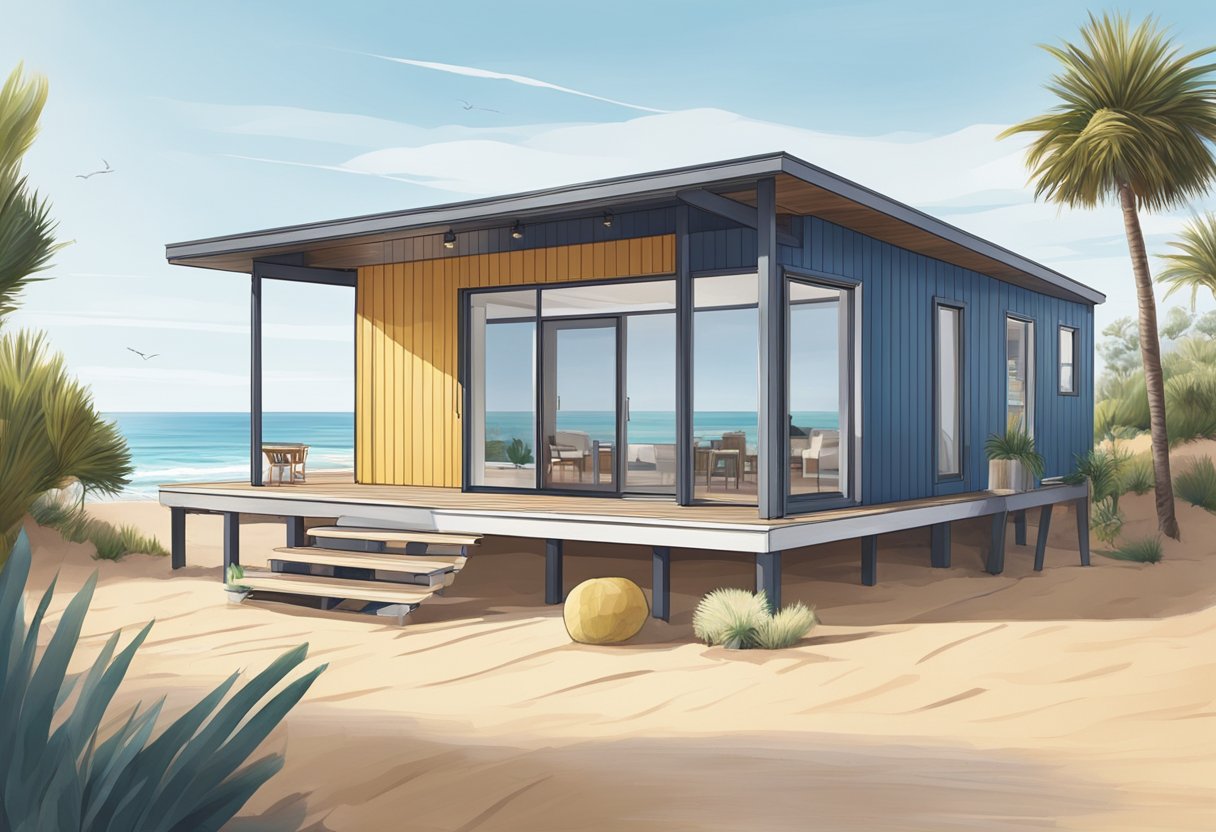Buying a Coastal Holiday Home in South Australia: A Comprehensive Guide

Table of Contents
Owning a coastal holiday home in South Australia presents an attractive opportunity for investors and families alike. This picturesque region boasts some of the most beautiful coastlines and serene atmospheres, making it an ideal destination for those seeking solace and tranquility in nature. For potential buyers considering investing in a cosy beach establishment, South Australia offers an enticing selection of properties that cater to various preferences and budgets.
One of the most significant advantages of purchasing a coastal holiday home in South Australia is the diverse range of coastal towns and communities to choose from. From the quaint charm of Victor Harbor to the vibrant allure of Port Lincoln, the region’s stunning locales offer something unique and captivating for everyone. Consequently, this lends itself well to the potential for strong rental demand and financial returns for property owners.
Moreover, investing in a beach holiday home presents a delightful opportunity for people to create lasting memories with loved ones while enjoying unmatched views and surroundings. South Australia’s welcoming communities, breathtaking landscapes, and an array of enjoyable activities make the prospect of buying a coastal holiday home in this region truly appealing.
Understanding the Market
When considering a coastal holiday home in South Australia, it’s essential to have a comprehensive understanding of the market. The real estate market in this region offers a variety of options, ranging from luxury villas to charming beach shacks. By examining the following factors, potential buyers can make an informed decision.
One important aspect to consider is the location. Coastal areas such as the Fleurieu Peninsula and the Yorke Peninsula provide diverse lifestyle opportunities as well as strong tourism industries. Kangaroo Island and the Limestone Coast are known for their picturesque landscapes and vast wildlife, attracting tourists and resulting in potential rental income opportunities.
The next factor to analyse is the property type. A mix of old and new properties can be found in South Australia. Buyers should assess the initial investment costs and potential ongoing maintenance expenses for each property type. For instance, newly built homes may have reduced maintenance expenses, while older beach houses might require renovations.
Keep a close eye on the local market trends to make well-informed decisions. These patterns may include property prices, rental yields, and economic factors such as employment rates and tourism numbers. Additionally, it is crucial to take note of any upcoming infrastructure projects and their potential impact on the local area. These developments can significantly influence future property prices and rental demand.
- Property Prices: Take time to research recent sales and property prices in the desired location. A solid understanding of the local market helps buyers avoid overpaying for a property.
- Rental Yields: Investigate the potential rental returns for the area, especially during peak holiday seasons. This information assists in estimating possible income and weighing it against the property’s expenses.
- Local Amenities: Evaluate the presence of amenities like shops, restaurants, transport, and recreational facilities. This factor can affect rental demand and property value.
By thoroughly researching the market and understanding these key factors, buyers can confidently find a suitable coastal beach holiday home in South Australia.
Location Selection
When choosing a location for a coastal holiday home in South Australia, there are several factors to consider. Firstly, consider the distance from major cities, such as Adelaide. Proximity to urban centres can influence the accessibility of essential services and the overall commute time for occasional visits or holiday stays.
A crucial factor in the selection is the type of beach environment desired. South Australia offers a diverse range of beach landscapes, from calm waters and sandy shores along the Fleurieu Peninsula, to the dramatic coastline and rugged cliffs of the Eyre Peninsula. Think about the type of leisure activities you enjoy, such as swimming, surfing, or fishing, and select a location accordingly.
Regarding location, consider the proximity to local amenities and attractions. A well-situated beach holiday home will enhance the convenience and appeal for both the property owner and potential holiday renters. Here are a few factors to consider:
- Beach access: Easy access to the beach itself is crucial for a successful holiday home investment.
- Recreational facilities: Proximity to parks, walking trails, or water sports facilities will add value.
- Local services: Nearby shops, cafes, grocery stores, medical facilities and restaurants can make the stay more convenient.
- Transportation: Accessibility by public transport or reasonable driving distance from major cities is also worth noting.
Lastly, consider your budget and the potential for capital growth in the chosen area. Property values in South Australia’s coastal regions can vary greatly, so be sure to research recent sales and property trends to make an informed decision.
By taking the time to consider the location factors mentioned above, you can confidently select the ideal coastal holiday home in South Australia that meets your requirements and preferences.
Property Type and Size

When considering a coastal home in South Australia, it is essential to choose the right property type and size that best suits individual preferences and needs. There are various property types to choose from, each with their unique features and benefits.
Detached beach houses provide a sense of privacy and space, making them an ideal choice for those looking to escape the hustle and bustle of city life. These properties typically offer multiple bedrooms, spacious living areas, and ample outdoor space for relaxation and entertainment. Detached homes also provide room for growth, making them an excellent investment for families planning to expand in the future.
Beach-side apartments and units are another popular option, offering modern amenities and convenient proximity to nearby shops, cafes, and recreational activities. These properties often come with a lower maintenance commitment, allowing homeowners to focus on enjoying their beach lifestyle. Apartments and units can range in size from cosy one-bedroom flats to larger three-bedroom penthouses, ensuring there is a suitable option for various needs and budgets.
For those seeking a more unique and rustic experience, beach cottages and cabins provide a charming atmosphere and often come with a rich history. These properties tend to be smaller and more intimate, making them perfect for couples or small families looking to create their beachside paradise.
When selecting the ideal property size, it is essential to consider factors such as the number of occupants, indoor and outdoor space requirements, and any specific needs related to accessibility and layout. Potential buyers should also factor in any plans for future growth or changes in the household and consider the implications of these changes on the property’s current and future suitability.
In summary, South Australia offers various beach holiday home options to cater to diverse preferences and needs. By carefully considering the property type and size, buyers can make an informed decision and find their perfect beach retreat.
Budgeting and Financing
When considering purchasing a country beach holiday home in South Australia, it’s essential to plan for both budgeting and financing. Determine the amount you can comfortably afford to invest in a property, taking into account your current financial situation, as well as the ongoing costs associated with owning a holiday home.
There are several factors to consider when establishing your budget:
- Purchase price: Research the current market prices in the areas you are interested in to understand the range of values for holiday homes. Keep in mind that factors such as proximity to the beach and local amenities can significantly affect the property’s price.
- Stamp duty and conveyancing fees: In South Australia, you must pay stamp duty on property purchases, which varies depending on the property’s value. Additionally, budget for legal fees associated with transferring the property title, known as conveyancing fees.
- Loan repayments: If you need to take out a mortgage, consider the interest rates, loan terms, and your ability to meet monthly repayments.
- Ongoing expenses: Remember that owning a holiday home comes with ongoing costs such as council rates, insurance, utility bills, and maintenance.
Once you have a clear understanding of your budget, it’s time to explore financing options. Some common financing strategies include:
- Mortgages: A home loan from a financial institution is a popular choice for purchasing a holiday home. Compare mortgages from multiple lenders to find the best interest rates and repayment terms. Don’t forget to factor in any additional fees.
- Using equity: If you own a primary residence, you may use your existing equity to help finance your holiday home purchase. Talk to your lender to see if this option is suitable for you.
- Joint ownership: Partnering with family or friends to purchase a holiday home can make the investment more affordable. Establish clear agreements about ownership shares, usage, and responsibilities to avoid potential conflicts.
Legal Aspects
When considering purchasing a coastal holiday home in South Australia, it is crucial to understand the legal aspects surrounding the buying process. In Australia, property laws and regulations vary between states; thus, it is critical that buyers familiarise themselves with South Australian legislation.
One key aspect to consider is the contract of sale, which outlines the terms and conditions of the purchase. In South Australia, this document must include specific information such as the property’s description, purchase price, deposit required, and settlement date. Engaging a conveyancer or solicitor can greatly assist in reviewing the contract and ensuring a seamless transaction.
Moreover, potential buyers should be mindful of stamp duty – a one-time tax levied by the South Australian government on property purchases. The amount payable depends on the property value, its purpose (e.g. primary residence or investment), and the buyer’s status (e.g. first-time homebuyer). To calculate the stamp duty, one can refer to the South Australian government’s official stamp duty calculator.
In addition, buyers need to secure land title registration and transfer of ownership. In South Australia, this process is facilitated by the Land Services department. Their online portal, called SAILIS, provides access to property-related data and enables electronic lodgement of title transfers. Buyers are encouraged to enlist the help of a conveyancer or solicitor in completing this process.
Lastly, it is important for buyers to be aware of any covenants or easements that may be associated with the property. Covenants are restrictions placed on the usage or development of the land, whereas easements grant access rights or usage permission to another party. These details can be found on the property’s certificate of title.
Inspection and Evaluation
When considering a coastal home in South Australia, it’s crucial to carefully conduct an inspection and evaluation of the property. Buyers should begin by examining the home’s exterior, assessing the condition of the walls, roof, and foundation for any signs of wear or damage. It’s especially important to pay attention to the potential impacts of the seaside environment, such as salt air corrosion or coastal erosion.
Inside the holiday home, buyers should focus on the key living areas, such as the kitchen, bedrooms, and bathrooms. Ensuring that the plumbing, electrical systems, and appliances are in good working order will help avoid costly repairs down the track. In addition, it’s essential to check for any signs of mould, mildew, or pest infestations, as these issues can exacerbate in a humid beachside climate.
It’s also valuable to assess the home’s energy efficiency, taking note of features such as insulation, double-glazed windows, and solar panels. These elements will contribute to a comfortable living environment and reduce ongoing utility costs. Moreover, buyers should also verify if the property has adequate water supply and waste management systems.
Before finalising any purchase, it’s essential to engage an independent building inspector and valuer to conduct a thorough assessment of the beach holiday home. This will provide an unbiased evaluation of the property’s condition and help buyers determine the fair market value. Ultimately, conducting a comprehensive inspection and evaluation ensures that property buyers make a well-informed decision when investing in a country beach holiday home in South Australia.
Property Maintenance
Purchasing a country beach holiday home in South Australia comes with the responsibility of ensuring regular property maintenance. There are several key aspects to consider when maintaining your beach property to ensure it remains in pristine condition.
Weather Conditions: Coastal properties are exposed to harsh weather conditions, such as salt spray and high humidity levels. Regularly inspect the exterior of the property, and consider using weather-resistant materials like stainless steel for fixtures. Cleaning external surfaces, windows and gutters reduces the risk of corrosion and ensures the longevity of the building.
Invasive Species: Beach homes are prone to pests, such as termites and rodents. Regular pest inspections can help prevent infestations, while a well-maintained garden will deter unwanted critters. It is also crucial to be aware of local plant species, as some invasive species can out-compete native vegetation and destabilise sand dunes.
Utilities: Regularly check and maintain your property’s utilities, including plumbing, gas, and electrical systems. Ensure that smoke detectors and safety switches are functioning and up-to-date. When necessary, consult professional service providers to guarantee safe and optimal functionality.
Cleaning and Upkeep: Maintain a consistent cleaning schedule to prevent the accumulation of sand, mould or mildew inside the property. Thoroughly clean upholstery and furniture to ensure they remain in good condition. Do not forget to service appliances such as air conditioning units, which require regular maintenance to function effectively.
By consistently addressing these maintenance aspects, your country beach holiday home in South Australia will remain a comfortable and enjoyable retreat for years to come.
Rental Income Potential
The country beach holiday homes in South Australia offer an appealing investment opportunity due to their potential for generating rental income. As more holidaymakers choose to stay in Australia amidst travel restrictions and preferences for quiet escapes, the demand for country beach homes is on the rise.
The picturesque landscapes and vast coastline draw both local and international tourists, making South Australia an attractive destination. With a variety of accommodations, from luxurious homes to quaint beachfront cottages, investors have multiple options to cater to different budgets.
Factors influencing rental income potential include property size, location, and amenities. Larger properties with modern amenities in popular locations can command higher rental rates. Additionally, rental income potential may vary depending on the season. Country beach homes are particularly popular during summer months, but some regions also attract tourists during offseason periods for events, festivals, and wine tours.
In terms of performance, property investors can look to the South Australian Tourism Commission and online rental platforms, such as Airbnb and Stayz, to gather data on rental yields, vacancy rates, and trends in the local market. Researching comparable properties in the area will provide valuable information on how the property could perform.
Property owners can further optimise rental income by employing property management services, which can ensure the highest levels of convenience, cleanliness, and comfort for guests. A well-maintained property attracts positive reviews, leading to higher occupancy rates and the potential for increased prices.
Exit Strategies
Investing in a country beach holiday home can be a rewarding and profitable venture. However, it is crucial for investors to have a well-thought-out exit strategy before making such an investment. This section discusses a few exit strategies to consider when purchasing a beach holiday home.
Selling the Property: One common exit strategy is to sell the property when its market value has significantly increased. This can happen due to various factors, such as property improvements, increased demand for beach homes, or a general rise in the local real estate market. Investors can work with trusted real estate agents to stay updated on market trends and get professional guidance on when and how to sell the property.
Long-term Rentals: Another option is to earn steady income through long-term rentals. Investors can rent out their holiday homes to tenants who are looking for a beachside residence in the area. This strategy helps in generating a stable cash flow, but it’s essential to be prepared to handle maintenance, repairs, and other landlord responsibilities.
Short-term Holiday Rentals: Capitalising on the popularity of beach holidays in South Australia, investors can list their properties on short-term holiday rental platforms such as Airbnb or local tourism operators. This strategy helps maximise occupancy and income during peak seasons, but it requires more attention to managing bookings, guest turnover, and property cleaning.
Lease-to-own Arrangements: A lease-to-own arrangement involves leasing the property to a tenant who has the option to purchase it after a predetermined period. This strategy can be beneficial for both parties, as the investor receives both rental income and the assurance that there’s a potential buyer for the property, while the tenant gets the opportunity to become a property owner without having to secure a separate mortgage.
Before deciding on an exit strategy, it’s important for investors to evaluate their financial goals, risk tolerance, and timeline. A well-planned exit strategy will help maximise returns on investment when it’s time to move on from the beach holiday home.
Conclusion
Purchasing a country beach holiday home in South Australia can be both a financially rewarding and enjoyable experience. The region offers a wide range of coastal properties to suit various budgets and preferences.
Choosing the right location is essential for making the most of your investment. Some popular areas include the Fleurieu Peninsula, Yorke Peninsula, and the Limestone Coast. Each area boasts unique attractions, such as pristine beaches, stunning natural landscapes, and charming local communities that are sure to enhance your holiday experience.
When considering financing options, it is advisable to research different mortgage products and consult with a financial advisor. This ensures that your investment aligns with your financial goals and minimises potential risks.
In summary, investing in a country beach holiday home in South Australia can be a wise decision with numerous benefits. Careful consideration of factors such as location, property type, and financing options will help you make an informed choice and set the foundation for memorable holidays and strong financial returns.


